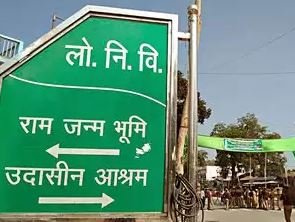When BJP had adopted Ram Mandir as part of its political agenda at Palampur in 1989, it had ruled out any settlement through the courts, while agreeing to a possible solution by dialogue or through Parliament.

By Neerja Chowdhury
Many did expect the Ayodhya verdict to be in favour of a Ram Mandir. What came as a surprise, though, was that Saturday’s judgment was unanimous, with no subsequent sign of triumphalism from the ‘winning side’. Also, the Muslim community, which lost its claim to the disputed site, responded with restraint and responsibility. Sure, there were voices expressing disappointment and injustice. But there was no visible attempt to exhort people to publicly oppose the verdict, as has happened in the past.
The Supreme Court verdict was a finely calibrated attempt to balance claims and counterclaims, with a view to bring closure to an issue that defied a solution for at least four decades, dividing society and polity as no other issue has in recent times. The court was tasked with a job that should have been that of the political executive.
Some efforts by earlier administrations had ‘almost succeeded’, but were undone by political one-upmanship — such as the attempt made by Krishan Kant and Mohammad Yunus Saleem, governors of Andhra Pradesh and Bihar during V P Singh’s prime ministership respectively; or the prolonged conversations with sadhus and sants by Prime Minister P V Narasimha Rao till 1992, or even spiritual leader Sri Sri Ravi Shankar’s mediatory efforts earlier this year.
In 1991, Congress had even pulled the plug on Prime Minister Chandra Shekhar government purportedly because he was on the verge of a breakthrough. There were too many players in the picture to bring all to a consensus. But with its judgment on Saturday, the Supreme Court finally belled the cat. Truth be told, it wasn’t as much of a title suit that it adjudicated, but a mediatory exercise it conducted.
When BJP had adopted Ram Mandir as part of its political agenda at Palampur in 1989, it had ruled out any settlement through the courts, while agreeing to a possible solution by dialogue or through Parliament. The now legally sanctioned construction of the mandir will credit Prime Minister Narendra Modi in ticking yet another box of the BJP’s core agenda (coming, as it does, soon after the suspension of Article 370 and the criminalisation of instantaneous triple talaq), reinforcing his image as the solver of knotty, festering national problems.
Vote, support & elect: Peace
But Ayodhya may not be a poll issue in mid-2022 when Uttar Pradesh is scheduled to go to polls, even as BJP will try and encash the construction of a ‘bhavya (grand) mandir’ that it hopes to have in place by then. The mandir became a potent political issue when there was opposition it, and when ‘newly politicised’ Hindus considered Ayodhya to be Ram’s janmabhoomi (birthplace). Now, with everyone accepting it, and with a temple about to become a reality, it is unlikely to be an emotive issue. In fact, BJP has known for some time now that the Ram Mandir had become a non-milch cow, as far as votes are concerned.It made sense for the ruling side to opt for a restrained response to the ‘promandir’ verdict instead of an in-your-face celebratory reaction. The ‘nobody’s victory and nobody’s defeat’ approach notably struck by Modi raised his stock as prime minister of India, rather than ‘Hindu Hriday Samrat’. But it also helps in the enforcement of law and order, which will help India’s image abroad and hopefully deter potential foreign investors from writing India off as a communal danger zone.
It made sense for the ruling side to opt for a restrained response to the ‘promandir’ verdict instead of an in-your-face celebratory reaction. The ‘nobody’s victory and nobody’s defeat’ approach notably struck by Modi raised his stock as prime minister of India, rather than ‘Hindu Hriday Samrat’. But it also helps in the enforcement of law and order, which will help India’s image abroad and hopefully deter potential foreign investors from writing India off as a communal danger zone.
It was after RSS upped the ante last winter by demanding a Ram Mandir be built by bringing in an Ordinance or by enacting a law that the Supreme Court was nudged to move towards a conclusive verdict. The ‘closure’ of the Ayodhya issue does not mean an end to BJP’s Hindutva agenda. Hindutva has, for all purposes, become a mainstream force today. So, will it open the door to an agitation on Kashi and Mathura? Very doubtful indeed. For good measure, the Supreme Court reminded the country of the 1997, barring the Ramjanmabhoomi.
‘Closure’ may mean that the BJP administration would now be in a better position to pursue an agenda of (Hindu) nationalism — be it through the National Register of Citizens (NRC), the Citizenship Amendment Bill, Pakistan or some other yet-to-be concocted issue — combined with the delivery of social goods to the masses, without being pushed around by its friends in the RSS or VHP.
Post-temple, a new template
Many of India’s Muslims feel a ‘loss of confidence’ to be able to raise their voice on issues ‘as Indians’ without being reminded of their religious identity. But they have decided not to be provoked by the Ayodhya verdict. The Supreme Court, on its part, has tried to make amends for the ‘desecration’ and demolition of the Babri Masjid by invoking its special powers to grant 5 acres for a mosque to be constructed in Ayodhya.
In their moment of ‘victory’, ordinary Hindus could also consider doing their bit by offering kar seva for the construction of the mosque. And, hopefully, Muslim Indians can also participate in the construction of the Ram mandir. Mere symbolism as this may be, such acts may go to underscore the ‘bhaichara’, or brotherhood, which everyone keeps talking about, and has, despite ruptures, underpinned the principles of the Indian republic.
